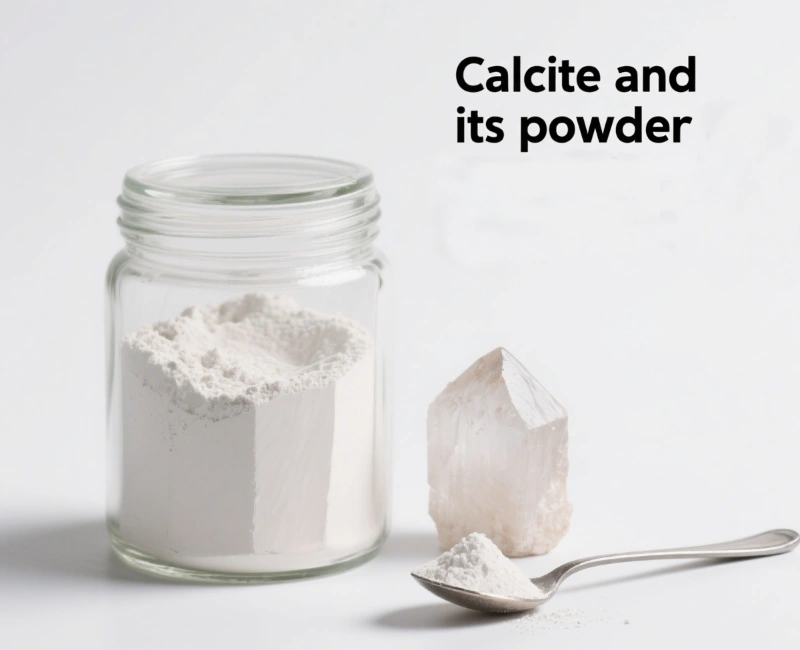Although both calcite powder and marble powder belong to calcium carbonate powder, they have obvious differences in specific applications due to different raw material sources, structural characteristics and processing technologies. Understanding their differences will help make more reasonable material choices in industries such as plastics, coatings, and building materials. Thereby improving product performance and cost-effectiveness.
Comparison of Mineralogical Nature and Physicochemical Properties:

Differences in Mineral Composition and Structure
Calcite powder:
The main component is calcium carbonate (CaCO₃), the crystal structure is trigonal, and the pure product is colorless and transparent. However, natural calcite often appears grayish white, light yellow, etc. due to impurities such as magnesium, iron, and manganese. Its Mohs hardness is 3, the relative density is 2.71, it has good cleavage, and the powder particles are mostly in the form of rhombohedral crushing.
Marble powder:
It belongs to metamorphic rock powder, and the main mineral is still calcite (content ≥50%). However, it is often accompanied by impurities such as dolomite (CaMg (CO₃)₂), quartz, and mica. In terms of structure, due to the influence of geological metamorphism, the crystal particles are coarser and denser. Mohs hardness is 3.5-5, relative density is 2.6-2.8, and flaky or granular composite particles can be seen in the powder.
Comparison of Key Physical and Chemical Indicators
| Indicators | Calcite powder | Marble powder |
| CaCO₃ purity | ≥95% (industrial grade) | 70%-90% (affected by impurities) |
| Impurity ingredients | Common Fe₂O₃, MgO | Contains SiO₂, Al₂O₃, dolomite, etc. |
| Whiteness | 85-95(high purity up to 97) | 75-85(affected by pigment impurities) |
| Oil absorption value (ml/100g) | 15-30 (the particle surface is relatively smooth) | 25-40 (high porosity of flaky particles) |
| pH value | 8.0-9.0 (weakly alkaline) | 7.5-8.5 (slightly less affected by impurities) |
Powder Processing Characteristics and Classification Suitability

Differences between Grinding and Classification Processes
Calcite powder:
Due to its low hardness and well-developed cleavage, it is suitable for dry grinding by Raymond mill, ball mill, etc. It is easy to obtain ultrafine powder with D50=1-10μm. During classification, due to the regular shape of the particles, the movement trajectory is stable in the centrifugal field. The HTS series airflow classifier can achieve high-precision classification of D97=3μm, and the over-crushing rate is <5%.
Marble powder:
When it contains hard impurities such as quartz, it needs to be crushed by impact mill or airflow mill (such as fluidized bed collision mill), and the energy consumption is 20%-30% higher than that of calcite. During classification, because the flaky particles are easy to agglomerate, it is necessary to cooperate with supersonic disperser (pressure 0.6-0.8MPa) to destroy the agglomerates. And the classification accuracy is reduced. When D97=5μm, the classification efficiency is only 70% of calcite.
Surface Modification Adaptability
- The hydroxyl groups on the surface of calcite powder are uniform. After modification with stearic acid (dosage 1.5-2.0%), the activation degree can reach 98%. It is suitable for scenes that require high dispersibility, such as PVC pipes.
- Due to the complex surface active groups of impurities in marble powder, the dosage of modifier (such as titanate coupling agent) needs to be increased to 2.5-3.0%. Moreover, the contact angle after modification is 10°-15° lower than that of calcite, which is prone to uneven dispersion problems in rubber products.
Differentiation of Application Areas

Plastics Industry:
Calcite powder:
Advantage scenario: Add 3-5% ultrafine calcite powder (D50=2μm) to transparent film (such as food packaging film). Because the refractive index is close to PE (1.48 vs 1.52), the transmittance only decreases by 2-3%. At the same time, the tensile strength is increased by 10-15%;
Process points: Fe₂O₃<0.1% must be controlled to avoid catalytic oxidation during aging.
Marble powder:
Typical application: calcium plastic box (addition amount 30-40%), using its flake structure to increase the bending modulus of the sheet (up to 1500MPa). However, due to the low whiteness, it needs to be matched with titanium dioxide (dosage 2-3%);
Limiting factors: When containing SiO₂>5%, it will accelerate the wear of the injection molding machine screw (the wear amount is 3 times higher than that of calcite).
Coatings and Inks
Calcite powder:
Used as a body pigment in high-end interior wall paints. Ultrafine powder with D50=1-3μm can fill the pores of the paint film, increase the gloss to 60° (60° gloss meter), and the low oil absorption value can reduce the amount of resin.
Using surface-modified calcite powder (activation degree > 95%) in ink can improve fluidity (viscosity decreases by 15-20mPa・s). This can avoid the problem of clogging.
Marble powder:
Used as aggregate in water-based exterior wall paints (D50=5-10μm), its rough surface is used to enhance the stain resistance of the coating (stain level 1). However, the water-soluble salt must be controlled to < 0.1% to prevent efflorescence.
Due to the fluorescent effect of impurities, it cannot be used in ultraviolet light-curing inks (UV inks), otherwise it will cause color shift after curing.
Conclusion
The choice between calcite powder and marble powder is essentially a triangular balance of “purity – cost – performance”. The former dominates the high-end market with high purity and processing adaptability. The latter occupies the mid- and low-end fields with the advantages of comprehensive resource utilization. Nano-modification, composite classification and other technologies are gradually breaking the boundaries of traditional applications and promoting the cross-application of the two types of powders in emerging fields such as new energy and biomedicine.
Epic Powder
Epic Powder, 20+ years of work experience in the ultrafine powder industry. Actively promote the future development of ultra-fine powder, focusing on crushing, grinding, classifying and modification process of ultra-fine powder. Contact us for a free consultation and customized solutions! Our expert team is dedicated to providing high-quality products and services to maximize the value of your powder processing. Epic Powder—Your Trusted Powder Processing Expert !
